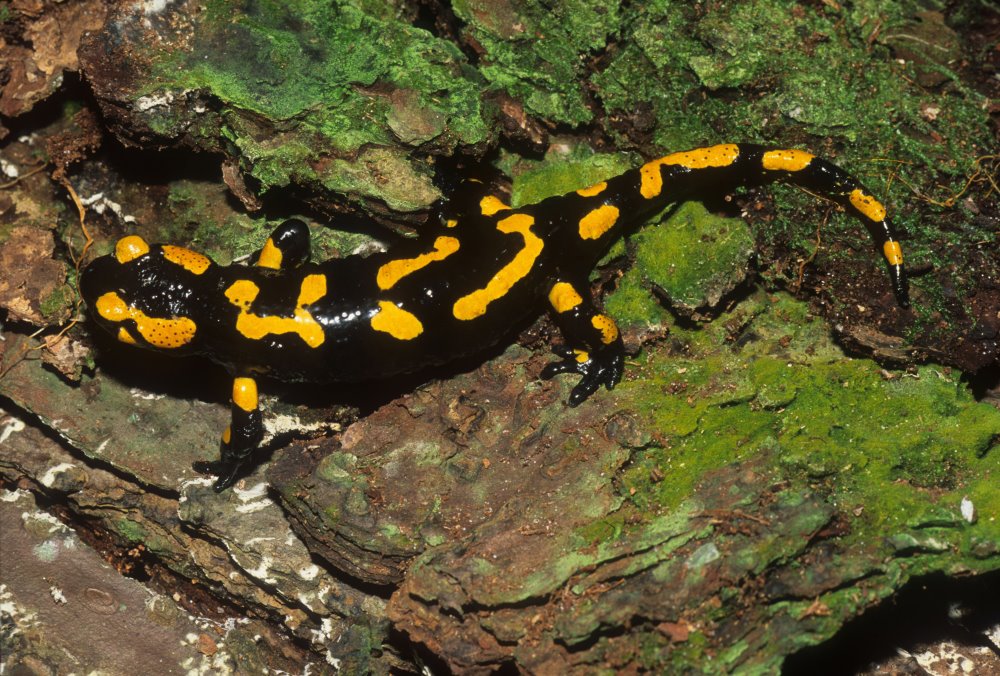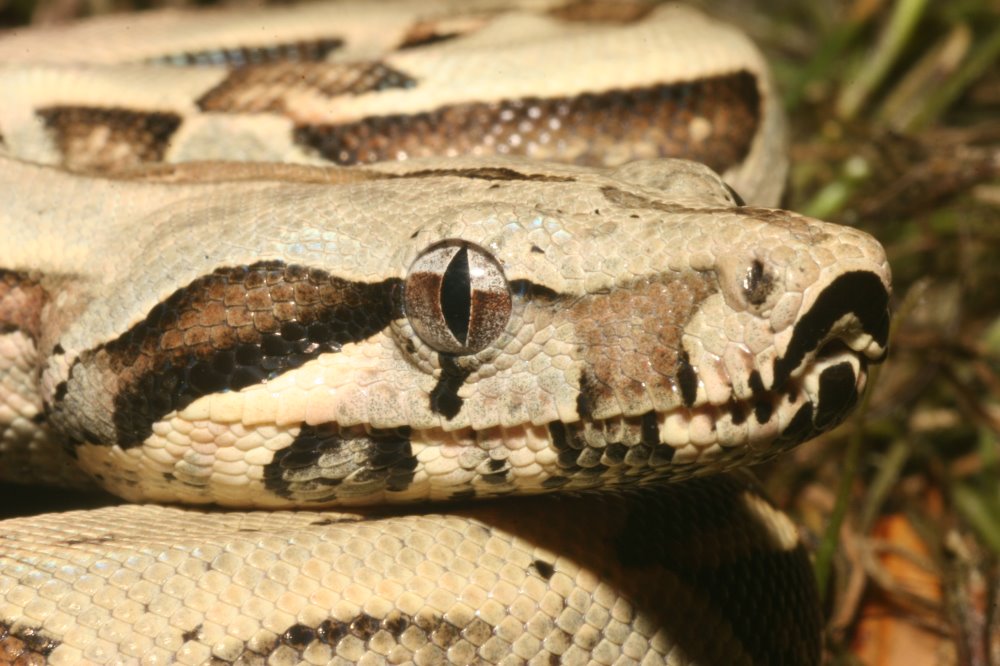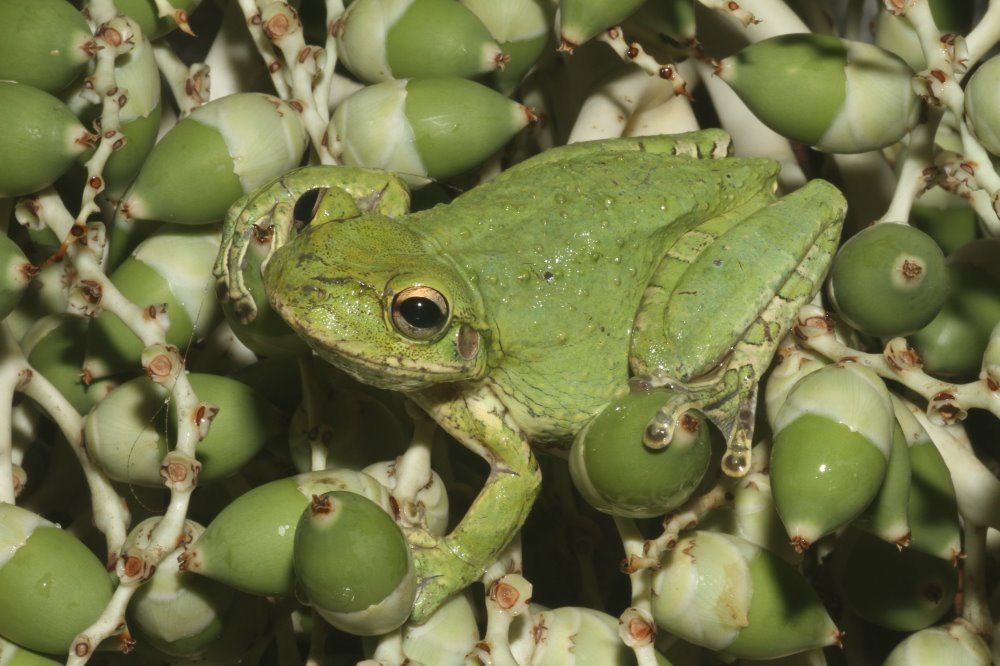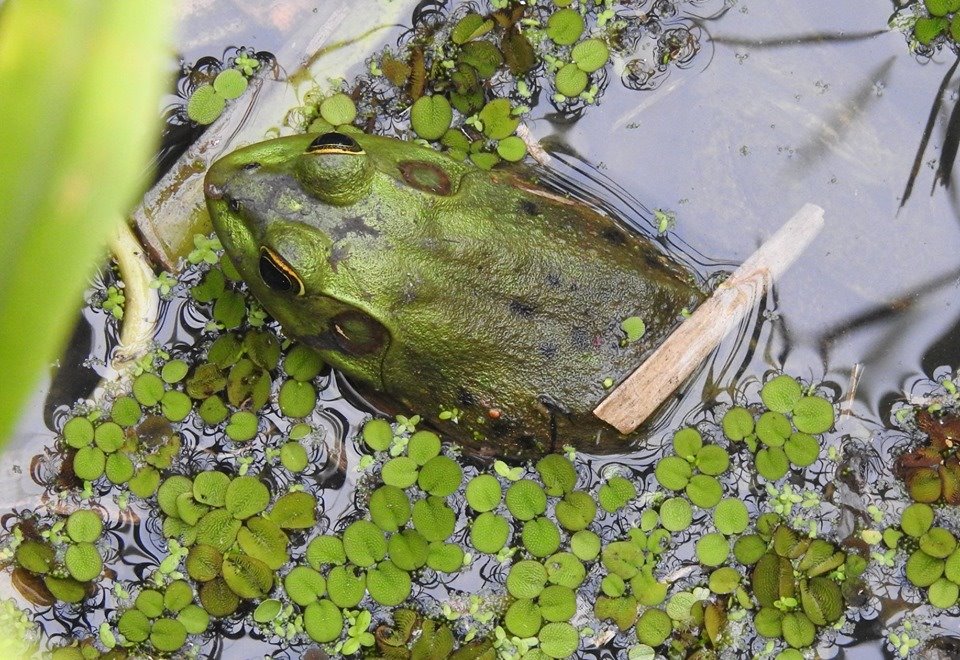Reptile & Amphibian
News Blog
Keep up with news and features of interest to the reptile and amphibian community on the kingsnake.com blog. We cover breaking stories from the mainstream and scientific media, user-submitted photos and videos, and feature articles and photos by Jeff Barringer, Richard Bartlett, and other herpetologists and herpetoculturists.
Tuesday, December 31 2019
This little Caiman in our Herp Photo of the day, uploaded by kingsnake.com user roadkill55 is feeling SASSY! Say goodbye to 2019 safely tonight! Be sure to tell them you liked it here!

Upload your own reptile and amphibian photos at gallery.kingsnake.com, and you could see them featured here!
Monday, December 30 2019

Bluish and caramel is just one of the colors of the variable ground snake.
Those among you who think snakes can be identified by color will likely find the profile of this diminutive burrower disconcerting. Having a record length of nearly 19 inches, the nonvenomous and harmless Variable Ground Snake is more typically 10 to 13 inches long. Ranging westward from western Missouri and eastern Texas to southeastern California and northwestern Nevada, this is a grassland/aridland snake that is most often found beneath flat stones and other ground surface debris. It feeds on insects and other small arthropods (ie centipedes, scorpions, spiders, etc.). The ground snake’s head is slightly wider than its neck, a helpful identifying characteristic.
And now for the color—ready for this? First the belly; this is unmarked and may be white, cream, or pale yellow. The underside of the tail may be unmarked or banded. Now to the dorsum. This may be steel gray, tan, fawn, cinnamon or other brownish hues and may be unpatterned, have a brown to reddish dorsal stripe, or have only a darker brown to black head. Or it may have the anterior or even the entire body saddled with broad black markings. As if this were not confusing enough, the back may be cream to rich tan (the sides are usually somewhat lighter) and be saddled with darker gray, brown, blue, or red. The saddles may be few and far between, or many and close together, and may be only on the back or extend far down on the sides.
I guess that by now you can see why the term “variable” is a bit more fitting than “western” for this tiny, harmless, and beneficial snake.
Just as a by the way, this little burrowing snake makes an interesting and hardy, albeit secretive, captive. It usually feeds readily on crickets, waxworms, or tiny caterpillars. So---if you want to keep a pet snake but don't have room for a large terrarium consider a 10 gallon tank decorated with a few inches of earth and a securely supported flat rock beneath which the snake can hide, and if you have enough light a cactus or other succulent may be added. And don't forget a flat water dish. Good luck.
Continue reading "The Variable (or Western) Ground Snake"
This gorgeous Shinisaurus crocodilurus in our Herp Photo of the day, uploaded by kingsnake.com user lavadusch will hopefully be the brightest part of your day! Be sure to tell them you liked it here!

Upload your own reptile and amphibian photos photos at gallery.kingsnake.com, and you could see them featured here!
Friday, December 27 2019
There is so much to love about Colubrids, so why not celebrate them with a big ole pile of beauty in our Herp Photo of the day, uploaded by kingsnake.com user xtranch ! Be sure to tell them you liked it here!

Upload your own reptile and amphibian photos at gallery.kingsnake.com, and you could see them featured here!
Thursday, December 26 2019
A wonderful field find in Mexico of this Lyre Snake brightens your day in our herp photo of the day uploaded by kingsnake.com user Chuck_Ch ! Be sure to tell them you liked it here!

Upload your own reptile and amphibian photos photos at gallery.kingsnake.com, and you could see them featured here!
Wednesday, December 25 2019
We hope this Ball Python in our Herp Photo of the day, uploaded by kingsnake.com user toshamc,will bring you a lot of holiday Cheer! From our family to yours, we wish you a safe, healthy and happy holiday! Be sure to tell them you liked it here!

Upload your own reptile and amphibian photos photos at gallery.kingsnake.com, and you could see them featured here!
Tuesday, December 24 2019
One day to get things ready and this gecko is making those light look boring in our Herp Photo of the Day, uploaded by kingsnake.com user chrisvanaken! Be sure to tell them you liked it here!

Upload your own reptile and amphibian photos photos at gallery.kingsnake.com, and you could see them featured here!
Monday, December 23 2019
Santa's gecko elves are prepping to load the sleigh in our herp photo of the day, uploaded by kingsnake.com user Geckoranch ! Be sure to tell them you liked it here!

Upload your own reptile and photos at gallery.kingsnake.com, and you could see them featured here!

Salamandra salamandra is the fire salamander most often available in the pet trade.
Although they are now hard to access in the USA, occasional fire salamanders may be offered in the pet trade. They are, roughly speaking, the Old World ecological equivalent of our ambystomatid species.
Fire salamanders are lovers of coolness, their ranges extending from cool, temperate lowlands to high into the European Alps. They are ovoviviparous, adult females bearing about a dozen gilled, living young in cool shallows. The gills may be prominent and well-developed, or in the perpetual coldness of alpine regions, nearly entirely resorbed at birth.
When keeping and breeding fire salamanders, coolness and cleanliness should be your 2 major concerns (of course this holds true for all caudates). Since salamanders like to burrow, and must be moist, several inches of fresh, damp (NOT WET), unmilled sphagnum moss will adequately provide for their needs. Or if this simple setup is not to your taste, you may prefer to make a naturalistic masterpiece having plantings of mosses, selaginellas, or even readily available potted plants such as vining philodendrons. Flat rocks, and driftwood can then be added to your taste. As with the sphagnum, the substrate should be kept damp, not wet.
Since amphibians absorb their moisture requirements through their skins and mucous membranes, it is unnecessary to provide a drinking dish but this is optional and will be needed, as will temperature cycling, if successful breeding is to occur.
Although it is entirely unlike the newts in appearance, the European fire salamander is a member of the same family, the Salamandridae. There are a number of subspecies (now often considered species) of this terrestrial caudate, their separation being based upon pattern (as well as locality and genetics).
The common fire salamander bears the redundant nomenclature of Salamandra salamandra. Hardly could a more beautiful salamander be imagined. The stocky, six inch length of the fire salamander is clad in glandular black skin highlighted with spots and stripes of intense, metallic, yellow. The head is broad and flattened and a pitted parotoid (nape) gland is present on both sides of the neck. The skin and parotoid secretions of the fire salamander are more toxic than are those of most other salamander species. Although it will not harm you (or them) to handle them gently, wash your hands before rubbing your eyes or putting your finger in your mouth.
Enough said.
Continue reading "Fire Salamanders"
Friday, December 20 2019
Happy Rattlesnake Friday! How stunning is the red on this Speckled Rattlesnake ( Crotalus mitchellii pyrrhus), uploaded by kingsnake.com user lichanura ! This Speck was found in Arizona. Be sure to tell them you liked it here! As always on Friday, we celebrate all of our venomous reptiles for their contribution to the world.

Upload your own reptile and amphibian photos at gallery.kingsnake.com, and you could see them featured here!
Thursday, December 19 2019
Kismet thinks Iguanas are better to lead Santa's Sleigh in our herp photo of the day, uploaded by kingsnake.com user Really! Be sure to tell them you liked it here!

Upload your own reptile and photos at gallery.kingsnake.com, and you could see them featured here!
Wednesday, December 18 2019
What a festive Tokay in our herp photo of the day, uploaded by kingsnake.com user bloodpython_MA ! Be sure to tell them you liked it here!

Upload your own reptile and photos at gallery.kingsnake.com, and you could see them featured here!
Tuesday, December 17 2019
Countdown to Christmas! This Green Tree Python is in the holiday spirit in our Herp Photo of the day, uploaded by kingsnake.com user toshamc ! Be sure to tell them you liked it here!

Upload your own reptile and amphibian photos photos at gallery.kingsnake.com, and you could see them featured here!
Monday, December 16 2019
We have the proof Santa is a reptile right here in our herp photo of the day, uploaded by kingsnake.com user rosebuds! Be sure to tell them you liked it here!

Upload your own reptile and photos at gallery.kingsnake.com, and you could see them featured here!

A profile of a South Florida boa constrictor.
Boa constrictors? In Florida? Don’t you mean pythons?
Ummmm. No. Believe me, I am well able to separate boas from pythons—even without a field guide in hand.
Unlike the pythons that continually, though inadvertently, grab the headlines, the boas are a quiet snake that has survived in a small section of Miami for close to 60 years. They are so retiring that even in the 1960s when I was avidly searching for them I was able to find only one. They are an easily handled and easily kept snake that has always been a hobbyist favorite. As hobbyists are wont to do, over time, decades actually, and many failed attempts, a number of color morphs have finally been developed and stabilized. Just a few of the 25+ variations now available from herpetoculturists are blood, albino, Arabesque, hypomelanistic, leopard, jungle, and sunglow phases.
The boas in the population being discussed here are of normal color and are the result of animal trade escapees from back as far as the 1950s. More than one subspecies was involved, which fact results today in pretty snakes of muddled subspecific appearance.
Today, after being basically ignored for many years the FWC has decided they should be eradicated and has asked that all found be humanely killed.
The boas are beautiful snakes that are patterned in tans and red with a little black and a little white mixed in. They are adult at 6 to 10 feet in length but are usually closer to the lower figure in that size estimate than the upper.
Continue reading "Florida’s Boa Constrictors"
Friday, December 13 2019
Happy Rattlesnake Friday! This Crotalus tigris, found and photographed in AZ, is keeping her eye on you in our herp photo of the day, uploaded by kingsnake.com user kevinjudd ! Be sure to tell them you liked it here!

Upload your own reptile and amphibian photos photos at gallery.kingsnake.com, and you could see them featured here!
Thursday, December 12 2019
Back in the field as this lovely Fire Salamander takes the spotlight in our Herp Photo of the day, uploaded by kingsnake.com user NYgaboon ! Be sure to tell them you liked it here!

Upload your own reptile and amphibian photos photos at gallery.kingsnake.com, and you could see them featured here!
Wednesday, December 11 2019
This gorgeous Ctenosaura quinquecarinata is just hanging around in our Herp Photo of the day, uploaded by kingsnake.com user rockabirdie ! Be sure to tell them you liked it here!

Upload your own reptile and amphibian photos at gallery.kingsnake.com, and you could see them featured here!
Tuesday, December 10 2019
What an awesome frilled dragon in our herp photo of the day, uploaded by kingsnake.com user frilly ! Be sure to tell them you liked it here!

Upload your own and photos at gallery.kingsnake.com, and you could see them featured here!
Monday, December 9 2019
So precious! We love hatchling photos, like this awakening Gecko in our Herp Photo of the day, uploaded by kingsnake.com user SA! Be sure to tell them you liked it here!

Upload your own reptile and amphibian photos photos at gallery.kingsnake.com, and you could see them featured here!

Often brown, the Cuban treefrog may change colors in only a few minutes.
Let’s talk Cuban Treefrogs, Osteopilus septentrionalis. These interesting frogs are not only now a very real part of Florida’s unnatural history, but have been for close to 80 years now. And no matter your outlook on their presence, you might as well face the fact that unless Mother Nature herself takes a hand, this frog is here to stay.
The Cuban treefrog is a member of the bony-headed treefrog group. It was introduced to the Florida Keys, probably inadvertently in commerce, in the 1920s. It thrived in its new home but its presence was basically ignored. By the early 1950s the frog populations had outgrown their insular home and had become well established on the southern peninsula. This fact was commented on by herpetologist-researcher, Al Schwartz. By 1958, when I moved to FL comments were being made about the voracious appetite of the Cuban treefrog and laments were heard that it would out compete (it can do so) and eat all of our native hylid frogs (at a 5.5” body length adult females would certainly be capable of eating most native species) and the demise of our natives within the growing range of the Cuban was imminent—totally and completely. But here we are, nearly three quarters of a century later, and this disappearance still hasn’t happened. Populations of native hylids may be somewhat reduced here and there, and we may have some fat Cuban treefrogs, but I can still go to the Everglades or Lake Okeechobee or almost anywhere else and still hear vibrant choruses of green treefrogs, squirrel treefrogs, and when within their ranges and habitats, of pine woods and barking treefrogs. Compare the statistics with habitat reduction or loss caused by humans and the “damage” caused by Cuban treefrogs is negligible. In fact, it is in disturbed areas that Cuban treefrogs seem most abundant.
Researchers at the Univ. of Florida have this to say about Cuban Treefrogs:
Cuban Treefrogs eat at least five different species of native frogs, not to mention the occasional lizard or small snake, and their tadpoles compete with native tadpoles for space and food. Cuban Treefrogs are common in urban areas, where they hang out near lights on the walls of houses and catch insects. They often poop on walls and windows (leaving ugly stains), take over birdhouses, and lay eggs in fish ponds and bird baths. Sometimes Cuban Treefrogs even find their way into homes, hanging out in toilets and clogging sink drains. Cuban treefrogs grow very large, and are known to cause costly power outages by short-circuiting utility switches. Our native treefrogs are all much smaller, and aren't known to cause such utility problems.
In other words, the Cuban treefrog is doing exactly what every other treefrog, every other anuran for that matter, does to exist. Asking the same question posed by Rob Macinnis, how long is a species required to live here to be granted the same consideration as a native taxon?
Please understand that I am not even suggesting how you should treat this species if you live in their ever-expanding range. We have them in our yard where they coexist with several other frog taxa. Here they are welcome.
Continue reading "The Cuban Treefrog "
Friday, December 6 2019
Happy Rattlesnake Friday! We are seeing red with this gorgeous shot of a Pygmy Rattlesnake our herp photo of the day uploaded by kingsnake.com user Tamers1 ! Be sure to tell them you liked it here!

Upload your own reptile and amphibian photos photos at gallery.kingsnake.com, and you could see them featured here!
Thursday, December 5 2019
Does a kingsnake really need an intro for our herp photo of the day, uploaded by kingsnake.com user trevid ? Nope, but hey nice grayband. Be sure to tell them you liked it here!

Upload your own reptile and amphibian photos photos at gallery.kingsnake.com, and you could see them featured here!
Wednesday, December 4 2019
Snakes and Cats living together, it will be anarchy! Wait what? Nah it is just a nice shot of a Cat Snake ( Boiga cyanea) in our Herp Photo of the Day, uploaded by kingsnake.com user ptahtoo! Be sure to tell ptahtoo you liked it here!
 Upload your own reptile and amphibian photos at gallery.kingsnake.com, and you could see them featured here!
Upload your own reptile and amphibian photos at gallery.kingsnake.com, and you could see them featured here!
Tuesday, December 3 2019
Poised and watching, what a stunning Mangrove in our herp photo of the day, uploaded by kingsnake.com user ptahtoo! Be sure to tell them you liked it here.

Upload your own reptile and amphibian photos at gallery.kingsnake.com, and you could see them featured here!
Monday, December 2 2019
Grumpy Toad is judging you in our Herp Photo of the day, uploaded by kingsnake.com user galen will blind ya! Be sure to tell them you liked it here!

Upload your own reptile and amphibian photos at gallery.kingsnake.com, and you could see them featured here!
 Here is a vocalizing male Barking Treefrog, Hyla gratiosa. By a small margin, this is our largest native eastern treefrog.
The calls echoed one another from both shoulders of the country roadway upon which Patti and I stood in the darkness. We were well away from the glare of city lights, and in the darkness of a new moon the heavens were fairly atwinkle with myriad stars.
From above us came the nasal "peeeents" of a nighthawk. We could picture it cleaving the darkened skies on white-barred wings as it sought its repast of flying insects. An occasional "whrroooomm" (wind through wing feathers) would divulge to us the fact that as well as feeding the nighthawks were indulging in courtship dives.
Even louder and more pervasive than the sounds of the nocturnal birds were those of the amphibians. A chorus of coarse, porcine, grunts from out the marshes were the calls of pig frogs, Rana grylio. Named for its porcine like notes, the pig frog is nearly as large familiar bullfrog, R. catesbeiana.
Vocalizing with the pig frogs, were fair numbers of a species at the opposite extreme of the size spectrum. This was the pretty and very variable little hylid frog that is known commonly as the Florida cricket frog. Scientifically it answers to the name of Acris gryllus dorsalis. This elfin frog must certainly have derived its name from its size for I perceive no similarity between its pebble-like clicking call and the notes of even a very out-of-tune cricket of any species.
During our evening's perambulations, we were serenaded by lesser numbers of numerous other species as well. Accompanied by the dot-dash calls of pine woods treefrogs, Hyla femoralis, inquisitive barred owls asked "who-cooks-for-you, who-cooks-for-you-all?" Green treefrogs, Hyla cinerea, "quonked," and a single barking treefrog, H. gratiosa, voiced its hollow notes. Wherever there was even a trace of moisture, little grass frogs, Pseudacris ocularis, our smallest anuran species, tinkled animatedly. These tiny hylids, adult females of which top out at a whopping 11/16ths of an inch, are the smallest species of anuran in the United States, and among the smallest in the world.
If closely analyzed Mother Nature’s evening choruses will introduce you to what is for many an unsuspected facet of the surrounding world. And it’s FREE! Partake.
Continue reading "A Florida Evening Chorus"
|



